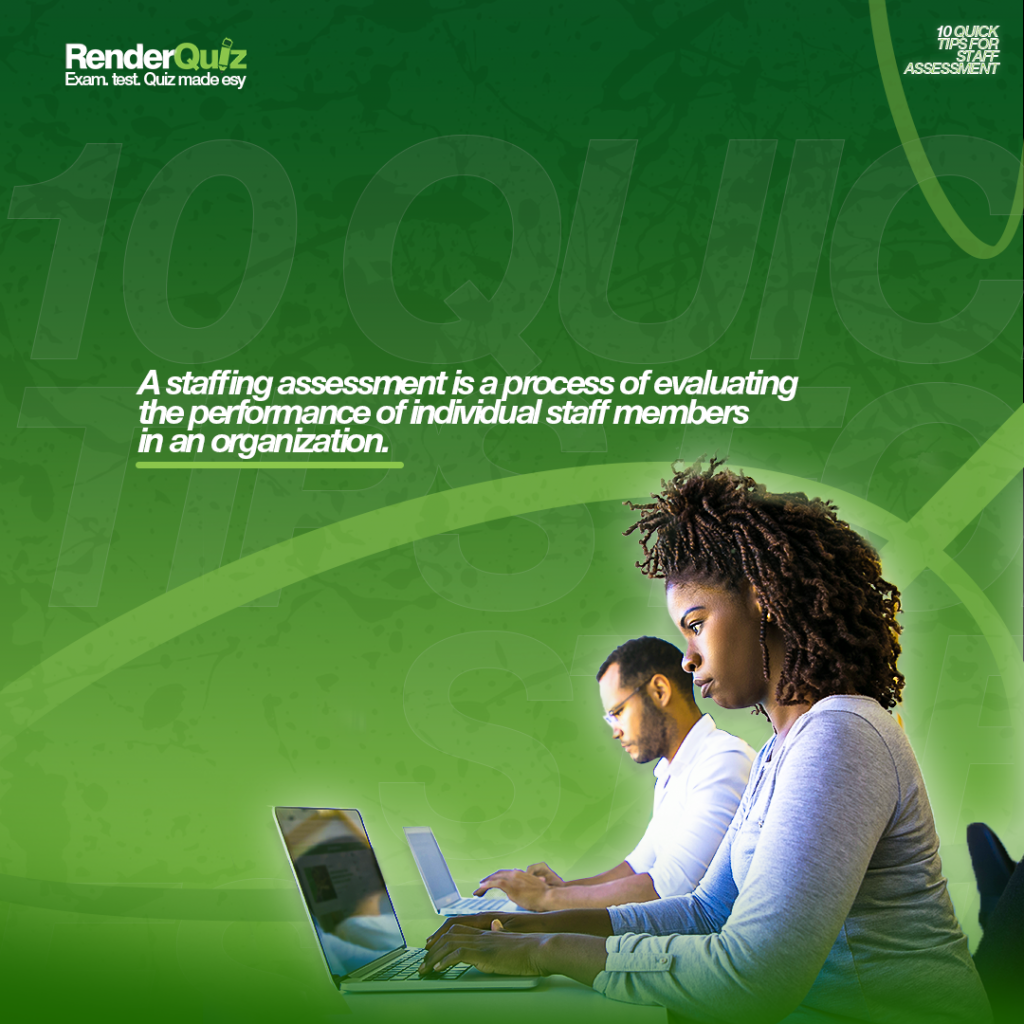A staffing assessment is a process of evaluating the performance of individual staff members in an organization. The purpose of a staff assessment is to highlight areas for growth and improvement, as well as to provide feedback to the staff member and to assist in the decision-making process when it comes to things like promotions, salary increases, and training opportunities.
The process of staff assessment typically involves setting performance goals, collecting data on the staff member’s performance, and conducting a formal review. The data collection can be done through various methods, such as observing the staff member in their work, collecting feedback from their colleagues and supervisors, or through self-assessment. The formal review is typically conducted by the staff member’s supervisor or manager and may include a face-to-face meeting or a written report.
The staff assessment process can be either formal or informal, depending on the company’s culture, size, and policies. Some companies use a formal process with a set of defined criteria, which includes objective and subjective performance measures, and often consists of a review of the employee’s job performance, skills, and growth potential. Other companies may use an informal process with little or no objective criteria, and the assessment is mainly based on the supervisor’s opinion of the employee’s performance.
Overall, the staff assessment process aims to align the staff member’s goals with the organization’s goals, develop the staff member’s skills, increase productivity, and improve the organization’s overall effectiveness.
Here are 10 Quick Tips For an effective staff Assessment
1. Set clear goals and expectations for the assessment process.
Setting clear goals and expectations for a staff assessment process helps ensure that the process is fair, objective, and effective. Assessments should be conducted by a neutral third party or a team of assessors to avoid any potential biases. It’s important to be transparent about the results and communicate them clearly and promptly.
2. Use a combination of quantitative and qualitative methods to assess staff performance.
You can use various quantitative and qualitative methodologies to evaluate staff performance. Quantitative methods measure how much work employees complete and how efficiently they work. Qualitative methods gather feedback and observations on other aspects of performance, such as communication skills or problem-solving abilities.
3. Provide regular feedback to staff throughout the year, not just during formal evaluations.
Managers and supervisors can help employees identify areas where they need to improve and provide them with the support and resources to do so. When employees receive regular feedback on their performance, they feel more engaged and invested in their work and are more likely to feel heard and valued by their employer.
If employees receive regular feedback from their employer, they are more likely to be aware of any concerns coming from their boss. Regular feedback can help increase an organization’s overall effectiveness and efficiency. It can also help to promote a sense of fairness and equity within an organization.
4. Encourage staff to set their own goals and assess their progress.
Allowing employees to set their own goals and assess their progress gives them greater autonomy, which can lead to improved productivity and job satisfaction. It is crucial to ensure that their goals align with the organization’s overall objectives and help employees with the necessary skills to track their progress toward achieving them.
It is essential to encourage this type of self-evaluation in your workforce, from improved motivation to better job satisfaction, which benefits both the employees and the organization.
5. Use various assessment tools such as self-evaluations, peer evaluations, and customer feedback.
Variossessment tools such as self-evaluations, peer evaluations, and customer feedback can provide valuable information about an individual’s or group’s performance. Managers and supervisors can use this information to set expectations and make decisions about promotions, transfers, and other personnel actions.
6. Allow staff to address any concerns or issues during the assessment process.
Staff can provide valuable insights into the areas where the organization excels and where improvements need to be made. This can help to identify potential blind spots or areas that have been overlooked by management. Allowing staff to voice their concerns during the assessment process can lead to a better understanding of the goals and objectives of the organization.
7. Use objective criteria to evaluate staff performance rather than relying solely on personal opinions.
Using objective criteria to evaluate staff performance is generally more fair and reliable than relying solely on personal opinions. This is because objective criteria are based on measurable and verifiable standards rather than on subjective judgments that personal biases or emotions can influence. It also helps reduce misunderstandings between supervisors and employees.
8. Provide training and resources to help staff improve their skills and performance.
Training and resources can lead to increased productivity, improved quality, and job satisfaction. It can also help organizations save money in the long run by reducing the need to hire new staff members. Proper training can ensure that staff members are aware of and comply with regulations.
9. Recognize and reward staff for their achievements and contributions.
Employees are more likely to feel valued and appreciated when their hard work and efforts are recognized and rewarded. This can lead to increased productivity, engagement and overall job satisfaction. It can also create a culture of excellence within an organization that encourages others to strive for similar success.
10. Continuously review and evaluate the assessment process to ensure that it is fair, practical, and relevant.
Assessments should be fair, practical, relevant, and compliant with legal regulations. Reviewing and evaluating the assessment process ensures that it meets the needs of all stakeholders. By identifying areas for improvement, we can make necessary adjustments to make the process more efficient and effective.
It’s worth mentioning that in order to have a well-rounded approach, staff assessment should not just focus on assessing the staff member but also on what kind of support and resources the organization can provide to help that person improve and excel. Also, being transparent on the process and providing clear expectations will help create trust and buy-in from the staff.


